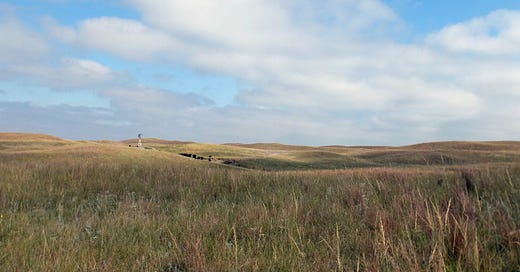This month’s post for paid subscribers is an excerpt from my 2019 book, Roadtripping at the End of the World.
September 14th, 2018
Most people who have driven through Nebraska remember it as flat and boring farmland and if you take the east-west I-80, which most people do, then yeah, that's mostly how it is.
There's more to see than that, but you've got to follow the smaller roads. I knew this from family vacations in my childhood, when we explored much of the northern and western parts of the state. One of my most vivid memories of these travels was visiting the Sandhills. I can clearly recall treeless rolling hills covered with grass, ponds in the crevices between the hills, exposed sand on the steeper slopes. The place has always stood out in my mind as one of great beauty and uniqueness. The beauty is a matter of taste that others might not share, but the uniqueness is real.
The Sandhills region is the largest formation of sand dunes in the entire Western Hemisphere. At roughly 265 miles long, east to west, and 125 miles wide, north to south, it is about 20,000 square miles in size (estimates vary depending on source). Individual dunes can be as tall as 400 feet and as long as 20 miles. Most people think of dunes as mounds of exposed sand constantly shifting in the wind and while this was the state of the Sandhills at one time in their history, they are now 95% covered with vegetation, most of which is grasses. The region belongs to the Tallgrass or Mixed Grass prairie depending on who you ask, but is best understood on its own terms.
Keep reading with a 7-day free trial
Subscribe to Speaking for the Trees, No Matter Where They're From to keep reading this post and get 7 days of free access to the full post archives.





